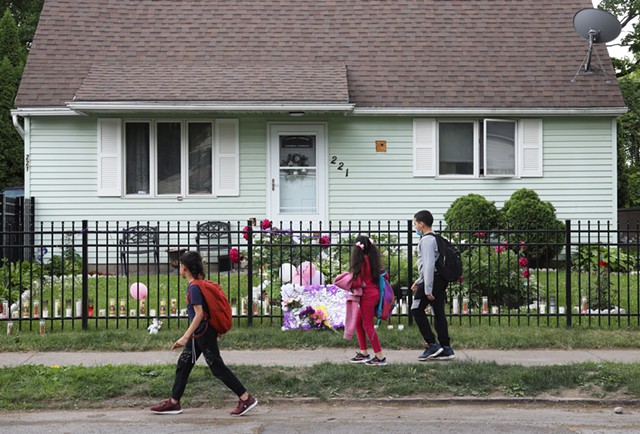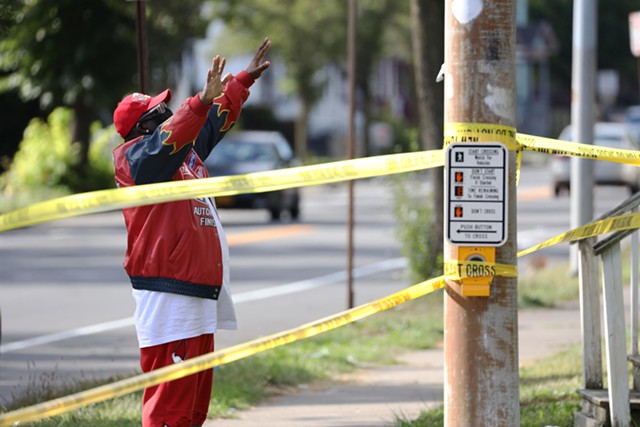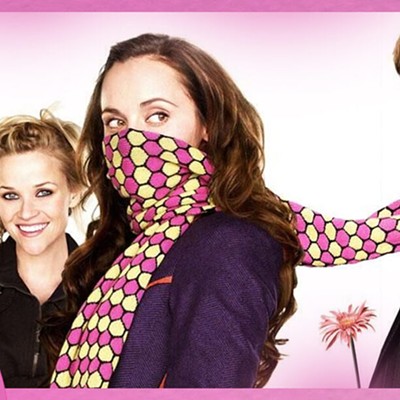[
{
"name": "500x250 Ad",
"insertPoint": "5",
"component": "15667920",
"parentWrapperClass": "",
"requiredCountToDisplay": "1"
}
]
Combined, the casualties in that span would constitute one of the bloodiest mass shootings in America this year if they occurred all in one incident. Instead, they happened in ones and twos, day by day, concentrated in the city's so-called Crescent neighborhoods among young Black victims. None attracted anything like the notoriety of the racially motivated killing of 10 Black people in Buffalo or, 10 days later, the slaying of 19 schoolchildren and two teachers in Uvalde, Texas.
Irshad Altheimer has seen this before. But the director of Rochester Institute of Technology's Center for Public Safety Initiatives said the pattern's predictability doesn't make the stark disparity of it any less disturbing.
"I'm very concerned that so much media coverage and so much societal attention to those horrible incidents kind of overshadows our need to have a really deeper discussion about what's going on with community violence," said Altheimer, whose center analyzes violence in Rochester and evaluates which programs work best to reduce everyday street violence.
There is a solid body of science identifying the strategies that work best to reduce that everyday kind of violence, which claims far more victims in the U.S. than the sort of domestic violence incidents and mass shootings that are the primary focus of the policies proposed in the latest round of this endless debate.
"It's not close," one gun-violence prevention expert, Thomas Abt, wrote on Twitter about the relative deadliness of the various types of gun violence. "If that [community] violence is left unaddressed by Congress, the undeniable implication is that those victims, despite their greater numbers, matter less."
Abt, who chairs the violent crime working group at the Council on Criminal Justice in Washington, D.C., turned the scholarly consensus about community-violence prevention strategies into an anti-violence playbook for cities in a 2019 book and in a pair of white papers for the council — one on community-led strategies and another on evidence-based policing. Together, the most effective strategies — things like highly-targeted policing combined with community-led interventions to steer high-risk people to safety — overlap little with the policies emanating from Albany and Washington in reaction to the latest mass shootings.
High-profile mass attacks, for obvious reasons, grab attention in dramatic fashion. But there's a deeper disconnect at work, stemming from lawmakers' preference for solutions that sound plausible, regardless of what the science tells us, and because the science of preventing mass shootings isn't as developed as it is for everyday violence prevention, said Jeffrey Butts, director of the Research and Evaluation Center at John Jay College of Criminal Justice in Manhattan.
"I would call the mass shooting a low-base rate problem," Butts said. "It's horrific but infrequent and unpredictable. That would be like developing a protocol for not just car crashes but crashes where someone intentionally runs into someone else. How do you develop policy for that?"
Mass shootings seem anything but infrequent, considering reporting that has become part of our mass-shooting response ritual. "There have been over 200 mass shootings so far in 2022," a Washington Post headline announced nine days after the attack in Texas. The New York Times weighed in the same day on the same theme, reporting, "Since the devastating attack on an elementary school in Uvalde, Texas, last week, mass shootings around the country have been relentless, coming at a pace of more than two a day."
Both reports, and many more, relied on the Gun Violence Archive, a nonprofit data collection project whose tallies of all types of gun violence have become a staple of mass-shooting news coverage. GVA, founded out of frustration that no government agency keeps real-time track of the toll of gun violence in America, uses an especially broad definition of mass shootings: where four or more people are wounded or killed "in a single event at the same general time and location" under any circumstance.
By a more traditional definition — one that the public most likely thinks of when we hear the phrase "mass shooting" — there have been exactly two incidents in 2022 as of June 15: in Buffalo and Uvalde. The numbers of these especially horrifying attacks have remained relatively constant over many years, around 1 percent of America's gun homicides, according to Everytown for Gun Safety.
That narrower definition, which the FBI refers to as "active shooter" mass murders and The Violence Project and others call "mass public shootings," singles out incidents where the killings of four or more people take place in public places and are not rooted in a more ordinary crime, like a robbery or fight, or where the attacker sets out to exact revenge on someone or something over a particular grievance. They fit the stereotypical image: rampages by disturbed men taking out their rage on random strangers.
Swept up in the much larger tally are the many ways Americans get shot by the thousands every year: in gang violence, petty arguments and other crimes, and over family and workplace grievances — almost always by shooters targeting people they know, and almost always using handguns instead of the assault-style rifles usually favored by the most notorious rampage killers.
Though rarer and less predictable, the horrifying mass shootings dominating the news are not immune to strategies that might prevent or at least minimize their damage. Based on a study of 600 attacks and plots, the federally funded Mass Attacks Defense Toolkit was published in June by RAND Corp. with a host of evidence-informed measures that community groups, police, schools and policymakers can take, from threat detection to discouraging copycats.
In a similar vein, the journal Criminology & Public Policy in February 2020 published a collection of 16 papers by 40 researchers compiling the best scientific findings to date on defining and effectively responding to mass shootings. (Disclosure: One of the sponsors of that academic project, the non-partisan Harry Frank Guggenheim Foundation, hired me to write a more digestible summary of the findings, published in April 2021.)
Among the key recommendations from that project: banning large-capacity gun magazines rather than the rifles themselves; gun-licensing and red-flag laws to keep more guns out of the hands of dangerous people; and better threat-assessment systems, since mass shooters usually telegraph their intent in advance.
One researcher, Daniel Webster of the Johns Hopkins Center for Gun Violence Solutions, cautioned during a June 2 online virtual briefing that "we can actually overemphasize" the differences between community gun violence and mass shootings. One big factor they have in common is overly easy access to guns capable of killing too many too quickly, he said.
As with any complex social problem, there is of course no single solution. But, in places like Rochester that have suffered record levels of street violence since 2020, deeply understanding the various types of violence and their causes, plus a dedication to following the evidence of what actually works to fix the problems, form the necessary first steps toward progress. That sounds obvious, perhaps, but not in the context of lawmaking driven by the latest catastrophes and a public conversation that seems to start and end on the notion that we just need to "do something."
"The whole public safety conversation right now is just so performative," said Butts, of John Jay College. "I would love to be optimistic. It's hard."
RIT's Altheimer said that's his take, as well, so long as real data take a back seat to assumptions about solutions driven by politics and uninformed assumptions. "You have to have a clear process and you have to assess it," Altheimer said. "And you gotta be willing to move on, if it doesn't have an impact — even if you like it."
Mark Obbie is a freelance journalist based in Canandaigua who covers gun violence policy nationally.









